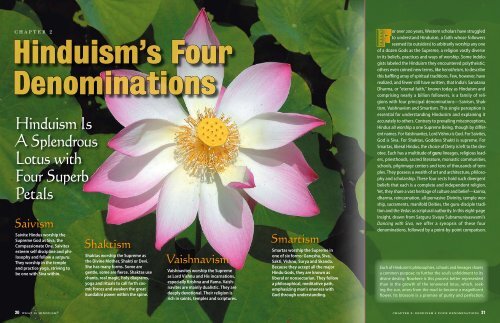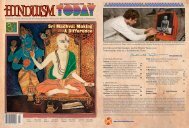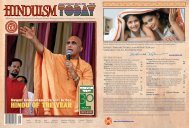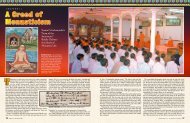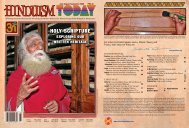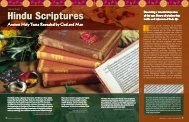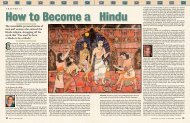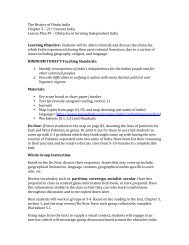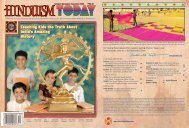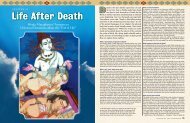Hinduism Is A Splendrous Lotus with Four Superb Petals
Hinduism Is A Splendrous Lotus with Four Superb Petals
Hinduism Is A Splendrous Lotus with Four Superb Petals
You also want an ePaper? Increase the reach of your titles
YUMPU automatically turns print PDFs into web optimized ePapers that Google loves.
Chapter 2<br />
<strong>Hinduism</strong>’s <strong>Four</strong><br />
Denominations<br />
<strong>Hinduism</strong> <strong>Is</strong><br />
A <strong>Splendrous</strong><br />
<strong>Lotus</strong> <strong>with</strong><br />
<strong>Four</strong> <strong>Superb</strong><br />
<strong>Petals</strong><br />
Saivism<br />
Saivite Hindus worship the<br />
Supreme God as Siva, the<br />
Compassionate One. Saivites<br />
esteem self discipline and philosophy<br />
and follow a sat guru.<br />
They worship in the temple<br />
and practice yoga, striving to<br />
be one <strong>with</strong> Siva <strong>with</strong>in.<br />
20 what is hinduism?<br />
Shaktism<br />
Shaktas worship the Supreme as<br />
the Divine Mother, Shakti or Devi.<br />
She has many forms. Some are<br />
gentle, some are fierce. Shaktas use<br />
chants, real magic, holy diagrams,<br />
yoga and rituals to call forth cosmic<br />
forces and awaken the great<br />
kundalini power <strong>with</strong>in the spine.<br />
Vaishnavism<br />
Vaishnavites worship the Supreme<br />
as Lord Vishnu and His incarnations,<br />
especially Krishna and Rama. Vaishnavites<br />
are mainly dualistic. They are<br />
deeply devotional. Their religion is<br />
rich in saints, temples and scriptures.<br />
Smartism<br />
Smartas worship the Supreme in<br />
one of six forms: Ganesha, Siva,<br />
Sakti, Vishnu, Surya and Skanda.<br />
Because they accept all the major<br />
Hindu Gods, they are known as<br />
liberal or nonsectarian. They follow<br />
a philosophical, meditative path,<br />
emphasizing man’s oneness <strong>with</strong><br />
God through understanding.<br />
F<br />
or over 200 years, Western scholars have struggled<br />
to understand <strong>Hinduism</strong>, a faith whose followers<br />
seemed (to outsiders) to arbitrarily worship any one<br />
of a dozen Gods as the Supreme, a religion vastly diverse<br />
in its beliefs, practices and ways of worship. Some Indologists<br />
labeled the <strong>Hinduism</strong> they encountered polytheistic;<br />
others even coined new terms, like henotheism, to describe<br />
this baffling array of spiritual traditions. Few, however, have<br />
realized, and fewer still have written, that India’s Sanatana<br />
Dharma, or “eternal faith,” known today as <strong>Hinduism</strong> and<br />
comprising nearly a billion followers, is a family of religions<br />
<strong>with</strong> four principal denominations—Saivism, Shaktism,<br />
Vaishnavism and Smartism. This single perception is<br />
essential for understanding Hinduisim and explaining it<br />
accurately to others. Contrary to prevailing misconceptions,<br />
Hindus all worship a one Supreme Being, though by different<br />
names. For Vaishnavites, Lord Vishnu is God. For Sai vites,<br />
God is Siva. For Shaktas, Goddess Shakti is su preme. For<br />
Smar tas, liberal Hindus, the choice of Deity is left to the devotee.<br />
Each has a multitude of guru lineages, religious leaders,<br />
priesthoods, sacred literature, monastic communities,<br />
schools, pilgrimage centers and tens of thousands of temples.<br />
They possess a wealth of art and architecture, philosophy<br />
and scholarship. These four sects hold such divergent<br />
be liefs that each is a complete and independent religion.<br />
Yet, they share a vast heritage of culture and belief—karma,<br />
dharma, reincarnation, all-pervasive Di vinity, tem ple worship,<br />
sac ra ments, manifold Deities, the guru-disciple tradition<br />
and the Vedas as scriptural authority. In this eight-page<br />
Insight, drawn from Sat guru Sivaya Subramuniyaswami’s<br />
Dancing <strong>with</strong> Siva, we offer a synopsis of these four<br />
denominations, followed by a point-by-point comparison.<br />
Each of <strong>Hinduism</strong>’s philosophies, schools and lineages shares<br />
a common purpose: to further the soul’s unfoldment to its<br />
divine destiny. Nowhere is this process better represented<br />
than in the growth of the renowned lotus, which, seeking<br />
the sun, arises from the mud to become a magnificent<br />
flower. Its blossom is a promise of purity and perfection.<br />
chapter 2: hinduism’s four denominations 21
What <strong>Is</strong> the<br />
Deeply Mystical<br />
Saiva Sect?<br />
Saivism is the world’s oldest religion.<br />
Worshiping God Siva, the<br />
compassionate One, it stresses<br />
potent disciplines, high philo sophy,<br />
the guru’s centrality and bhaktiraja-siddha<br />
yoga leading to oneness<br />
<strong>with</strong> Siva <strong>with</strong>in. Aum.<br />
Saivism is ancient, truly ageless, for<br />
it has no beginning. It is the precursor of<br />
the many-faceted religion now termed hinduism.<br />
Scholars trace the roots of Siva worship back<br />
more than 8,000 years to the advanced Indus Valley<br />
civ ilization. But sa cred writings tell us there never<br />
was a time when Saivism did not exist. Modern<br />
history re cords six main schools: Saiva Siddhanta,<br />
pashupatism, Kashmir Saivism, Vira Saivism, Siddha<br />
Siddhan ta and Siva ad vaita. Saivism’s grand eur<br />
and beauty are found in a practical culture, an enlightened<br />
view of man’s place in the universe and<br />
22 what is hinduism?<br />
art by s. rajam<br />
Seated on Nandi, his bull mount, the perfect devotee, Lord<br />
Siva holds japa beads and the trident, symbol of love-wisdom-action,<br />
and offers blessings of protection and fearlessness.<br />
Mount Kailas, His sacred Himalayan abode, represents<br />
the pinnacle of consciousness.<br />
a profound system of temple mys ti cism and siddha<br />
yoga. It provides knowledge of man’s ev o lution from<br />
God and back to God, of the soul’s un fold ment and<br />
awak ening guided by en lightened sages. Like all<br />
the sects, its majority are devout families, headed<br />
by hundreds of orders of swamis and sa dhus who<br />
follow the fiery, world-re nouncing path to moksha.<br />
the Ved as state, “By knowing Siva, the auspicious<br />
One who is hidden in all things, exceedingly fine,<br />
like film arising from clarified butter, the One<br />
embracer of the universe—by realizing God, one<br />
is released from all fetters.” aum Namah Sivaya.<br />
What <strong>Is</strong> the<br />
Magic and Power<br />
Of Shaktism?<br />
Shaktism reveres the Supreme as<br />
the Divine Mother, Shakti or Devi,<br />
in Her many forms, both gentle and<br />
fierce. Shaktas use mantra, tantra,<br />
yantra, yoga and puja to invoke<br />
cosmic forces and awaken the<br />
kundalini power. Aum.<br />
W<br />
hile worship of the divine mother<br />
e x t e n d s beyond the pale of history,<br />
Shakta hinduism arose as an organized<br />
sect in India around the fifth century. today it has<br />
four expressions—d e v o t i o n a l , fo l k- s h a m a n ic , yogic<br />
and universalist—all invoking the fierce power<br />
of Kali or Durga, or the benign grace of par vati<br />
or ambika. Shakta de vo tionalists use puja rites,<br />
especial ly to the Shri Chakra yan tra, to e s t abl i s h<br />
intimacy <strong>with</strong> the God dess. Sha man ic Shak tism<br />
employs magic, trance medium ship, firewalking<br />
and animal sacrifice for healing, fertility, pro ph e cy<br />
Shakti, depicted in Her green form, radiates beauty, energy,<br />
compassion and protection for followers. Wearing the<br />
tilaka of the Shakta sect on Her forehead, She blesses<br />
devotees, who shower rosewater, hold an umbrella and<br />
prostrate at Her feet.<br />
and power. Shakta yogis seek to awaken the sleeping<br />
Goddess Kundalini and unite her <strong>with</strong> Siva in<br />
the s a h a s ra ra chakra. Shak ta universalists follow<br />
the reformed Vedantic tradition ex em plified by Sri<br />
ram akrishna. “Left-hand” tan tric rites transcend<br />
traditional ethical codes. Shaktism is chiefly ad vaitic,<br />
de fin ing the soul’s destiny as complete identity <strong>with</strong><br />
the Un man ifest, Siva. Central scrip tures are the Vedas,<br />
Shakta Agamas and Pur a n a s . the Devi Gita<br />
extols, “We bow down to the uni ver sal soul of all.<br />
above and below and in all four directions, Mother<br />
of the universe, we bow.” aum Chandikayai Namah.<br />
chapter 2: hinduism’s four denominations 23
What <strong>Is</strong> the<br />
Devotional<br />
Vaishnava Sect?<br />
Vaishnavism is an ancient Hindu<br />
sect centering on the worship<br />
of Lord Vishnu and His incarnations,<br />
especially Krishna and Rama.<br />
Largely dualistic, profoundly<br />
devotional, it is rich in saints, temples<br />
and scriptures. Aum.<br />
The worship of vishnu, meaning “pervader,”<br />
dates back to Vedic times. the pancharatra<br />
and Bhagavata sects were popular<br />
prior to 300 bce. today’s five Vaishnava schools<br />
emerged in the middle ages, founded by ramanuja,<br />
Madh va, Nimbarka, Vallabha and Chaitanya. Vaishna<br />
vism stresses prapatti, single-pointed sur render<br />
to Vishnu, or his ten or more incarnations, called<br />
av a t a ra s . Jap a is a key devotional sannyasin, as is<br />
ecstatic chanting and dancing, called kirtana. temple<br />
worship and festivals are elaborately observed.<br />
philosophically, Vaishna vism ranges from Madh-<br />
24 what is hinduism?<br />
Vishnu is the infinite ocean from which the world emerges.<br />
He stands on waves, surrounded by the many-headed Seshanaga,<br />
who represents agelessness and is regarded as an<br />
extension of divine energy and an incarnation of Balarama,<br />
Lord Krishna’s brother.<br />
va’s pure du alism to ramanuja’s qualified nondualism<br />
to Vallabha’s nearly monistic vis ion. God and<br />
soul are everlastingly distinct. the soul’s destiny,<br />
through God’s grace, is to eternally worship and<br />
en joy him. While general ly nonascetic, advocating<br />
bhakti as the highest path, Vaish na vism has<br />
a strong mon astic community. Central scriptures<br />
are the Vedas, Vaish nava Aga mas, Itihasas and<br />
Puranas. the Bhagavad Gita states, “On those who<br />
meditate on Me and worship <strong>with</strong> un divided heart,<br />
I confer attainment of what they have not, and preserve<br />
what they have.” aum Namo Narayanaya.<br />
What <strong>Is</strong> the<br />
Universalistic<br />
Smarta Sect?<br />
Smartism is an ancient brahminical<br />
tradition reformed by<br />
Shankara in the ninth century.<br />
Worshiping six forms of God,<br />
this liberal Hindu path is monistic,<br />
nonsectarian, meditative<br />
and philosophical. Aum.<br />
S<br />
marta means a follower of classical<br />
smriti, particularly the Dharma Shastras,<br />
Puranas and Itihasas. Smartas re vere the<br />
Ve d a s and honor the Agamas. today this faith is<br />
synonymous <strong>with</strong> the teachings of adi Shankara,<br />
the monk-phil os opher known as Shanmata Sthapanacharya,<br />
“found er of the six-sect system.” he campaigned<br />
India-wide to con solidate the hindu faiths<br />
of his time under the banner of advaita Vedanta.<br />
to unify the worship, he popularized the an cient<br />
Smarta five-Deity altar—Ga na pati, Surya, Vishnu,<br />
Siva and Shakti—and added Kumara. From these,<br />
Adi Shankara lived from 788 to 820 ce, a mere 32 years, yet<br />
he gave <strong>Hinduism</strong> a new liberal denomination—Smartism.<br />
Here, wearing sacred marks, he holds his writings and is<br />
flanked by the six Deities of the Smarta altar: Surya the Sun,<br />
Siva, Shakti, Vishnu, Kumaran and Ganesha.<br />
devotees may choose their “preferred Deity,” or <strong>Is</strong>hta<br />
Devata. each God is but a reflection of the one<br />
Sa guna Brahman. Shankara organized hundreds<br />
of mon asteries into a ten-order, d a sh a na m i system,<br />
which now has five pontifical cen ters. he wrote<br />
profuse commentaries on the Upa ni sh ad s, Brah m a<br />
Sutras and Bhagavad Gita. Shankara proclaimed,<br />
“It is the one reality which ap pears to our ignorance<br />
as a manifold universe of names and forms and<br />
changes. Like the gold of which many or naments<br />
are made, it remains in itself un chang ed. Such is<br />
Brahman, and that art thou.” aum Namah Sivaya.<br />
chapter 2: hinduism’s four denominations 25
As j u s t seen, t h e s p e c t r u m<br />
of Hindu religiousness is<br />
found <strong>with</strong>in four major<br />
sects or denominations: Saivism,<br />
Shaktism, Vaishnavism and Smartism.<br />
Among these four streams, there are<br />
certainly more similarities than diferences.<br />
All four believe in karma and<br />
reincarnation and in a Supreme Being<br />
who both is form and pervades form,<br />
who creates, sustains and destroys<br />
the universe only to create it again<br />
in unending cycles. They strongly<br />
declare the validity and importance<br />
of temple worship, the three worlds<br />
of existence and the myriad Gods and<br />
devas residing in them. They concur<br />
that there is no intrinsic evil, that the<br />
cosmos is created out of God and is<br />
permeated by Him. They each believe<br />
in maya (though their definitions differ<br />
somewhat), and in the liberation of<br />
the soul from rebirth, called moksha,<br />
as the goal of human existence. They<br />
believe in dharma and in ahimsa, noninjury,<br />
and in the need for a satguru to<br />
lead the soul toward Self Realization.<br />
They wear the sacred marks, tilaka,<br />
on their foreheads as sacred symbols,<br />
though each wears a distinct mark.<br />
Finally, they prefer cremation of the<br />
body upon death, believing that the<br />
soul will inhabit another body in the<br />
next life. While <strong>Hinduism</strong> has many<br />
sacred scriptures, all sects ascribe the<br />
highest authority to the Vedas and<br />
Agamas, though their Agamas difer<br />
somewhat. Here, now, is a brief comparison<br />
of these four denominations.<br />
26 what is hinduism?<br />
On the Personal God/Goddess<br />
saivism: Personal God and temple Deity<br />
is Siva, neither male nor female. Lords<br />
Ganesha and Karttikeya are also<br />
worshiped.<br />
shaktism: Personal Goddess and temple<br />
Deity is Shri Devi or Shakti, fe male, worshiped<br />
as Rajarajeshvari, Parvati, Lakshmi,<br />
Sarasvati, Kali, Amman, etc. —the<br />
Divine Mother.<br />
vaishnavism: Personal God and temple<br />
Deity is Vishnu, male. His incar nations as<br />
Rama and Krishna are also worshiped, as<br />
well as His divine consort, Radharani.<br />
smartism: Personal God and temple Deity<br />
is <strong>Is</strong>hvara, male or female, worshiped<br />
as Vishnu, Siva, Shakti, Ganesha and Sur ya<br />
or another Deity of dev otee’s choice, e.g.,<br />
Kumara or Krishna.<br />
s. rajam<br />
On the Nature of Shakti<br />
saivism: Shakti is God Siva’s inseparable<br />
power and manifest will, energy or mind.<br />
shaktism: Shakti is an active, immanent<br />
Being, separate from a quiescent and<br />
remote Siva.<br />
vaishnavism: No special importance<br />
is given to Shakti. How ever, there are<br />
parallels wherein the divine consorts<br />
are conceived as the inseparable powers<br />
of Vishnu and His incarnations: e.g.,<br />
Krishna’s Radharani and Rama’s Sita.<br />
smartism: Shakti is a divine form of <strong>Is</strong>hvara.<br />
It is God’s manifesting power.<br />
On the Nature of Personal God<br />
saivism: God Siva is pure love and compassion,<br />
immanent and transcendent,<br />
pleased by our purity and sadhana.<br />
shaktism: The Goddess Shakti is both<br />
compassionate and terrifying, pleasing<br />
and wrathful, assuaged by sacrifice and<br />
submission.<br />
vaishnavism: God Vishnu is loving and<br />
beautiful, the ob ject of man’s devotion,<br />
pleased by our service and surrender.<br />
smartism: <strong>Is</strong>hvara appears as a human-like<br />
Deity according to devotees’ loving worship,<br />
which is sometimes considered a<br />
rudimentary, self-puri fying practice.<br />
On the Doctrine of Avatara<br />
saivism: There are no divine earthly<br />
incarnations of the Supreme Being.<br />
shaktism: The Divine Mother does<br />
incarnate in this world.<br />
vaishnavism: Vishnu has ten or more<br />
incar na tions.<br />
smartism: All Deities may assume<br />
earthly incarnations.<br />
On the Soul and God<br />
saivism: God Siva is one <strong>with</strong> the soul. The<br />
soul must realize this advaitic (monistic)<br />
Paths of Attainment<br />
saivism: The path for Saivites is divided into four progressive<br />
stages of belief and practice called charya, kriya,<br />
yoga and jnana. The soul evolves through karma and<br />
reincarna tion from the instinctive-intellectual sphere<br />
into virtuous and moral living, then into temple worship<br />
and devotion, followed by internalized worship,<br />
or yoga, and its meditative disciplines. Union <strong>with</strong> God<br />
Siva comes through the grace of the satguru and culminates<br />
in the soul’s maturity in the state of jnana, or wisdom.<br />
Saivism values both bhakti and yoga, devotional<br />
and contemplative sadhanas, or disciplines.<br />
shaktism: The spiritual practices in Shaktism are similar<br />
to those in Saivism, though there is more emphasis in Saktism<br />
on God’s Power as op posed to Being, on mantras and<br />
yantras, and on embracing apparent opposites: male-female,<br />
ab so lute-relative, pleasure-pain, cause-ef ect, mindbody.<br />
Certain sects <strong>with</strong>in Shaktism un der take “left-hand”<br />
tantric rites, consciously using the world of form to transmute<br />
and eventually transcend that world. The “left-hand”<br />
approach is somewhat occult in nature; it is considered a<br />
path for the few, not the many. The “right-hand” path is<br />
more con ser vative in nature.<br />
Artwork: The Divine is reflected in four pots, representing<br />
<strong>Hinduism</strong>’s four main denominations, their<br />
common source being the radiant Aum, the sacred<br />
mystic syllable and symbol of Sanatana Dharma.<br />
Truth by God Siva’s grace.<br />
shaktism: The Divine Mother, Shakti, is<br />
mediatrix, bestowing advaitic moksha on<br />
those who worship Her.<br />
vaishnavism: God and soul are eternally<br />
distinct. Through Lord Vishnu’s grace, the<br />
soul’s destiny is to worship and enjoy God.<br />
smartism: <strong>Is</strong>hvara and man are in reality<br />
Absolute Brah man. Within maya, the soul<br />
and <strong>Is</strong>hvara appear as two. Jnana (wisdom)<br />
dispels the illusion.<br />
Spiritual Practice<br />
saivism: With bhakti as a base, emphasis<br />
is placed on tapas (austerity) and yoga.<br />
Ascetic.<br />
shaktism: Emphasis is on bhakti and<br />
tantra, sometimes occult, practices.<br />
Ascetic-occult.<br />
vaishnavism: Emphasis is on supreme<br />
bhakti or surrender, called pra patti. Generally<br />
devotional and nonascetic.<br />
smartism: Preparatory sadhanas are<br />
bhakti, karma, raja yoga. The highest path<br />
is through knowledge, leading to jnana.<br />
Major Scriptures<br />
saivism: Vedas, Saiva Agamas and Saiva<br />
Puranas.<br />
shaktism: Vedas, Shakta Agamas (Tantras)<br />
and Puranas.<br />
vaishnavism: Vedas, Vaishnava Agamas,<br />
Puranas and the Itihasas (Ramayana and<br />
Mahabharata, especially the Bhagavad<br />
Gita).<br />
smartism: Vedas, Agamas and classical<br />
smriti—Puranas, Itihasas, especially the<br />
Bhagavad Gita, etc.<br />
Regions of Influence<br />
saivism: Strongest in South and North India,<br />
Nepal and Sri Lanka.<br />
shaktism: Most prominent in Northeast<br />
India, especially Bengal and Assam.<br />
vaishnavism: Strong throughout India,<br />
North and South.<br />
smartism: Most prominent in North and<br />
South India.<br />
vaishnavism: Most Vaishnavites believe that religion is the<br />
performance of bhakti sadhanas, devotional disciplines, and<br />
that man can com municate <strong>with</strong> and receive the grace of the<br />
Gods and Goddesses through the darshan (sight) of their icons.<br />
The paths of karma yoga and jnana yoga lead to bhakti yoga.<br />
Among the foremost practices of Vaishnavites is chanting the<br />
holy names of the Avataras, Vishnu’s incarnations, especially<br />
Rama and Krishna. Through total self-surrender, prapatti, to<br />
Vishnu, to Krishna or to His beloved consort Radharani, liberation<br />
from samsara (the cycle of reincarnation) is attained.<br />
smartism: Smartas, the most eclectic of Hindus, believe that<br />
moksha is achieved through jnana yoga alone—defined as an<br />
intellectual and meditative but non-kundalini-yoga path. Jnana<br />
yoga’s progressive stages are scriptural study (shravana), reflection<br />
(manana) and sustained meditation (dhyana). Guided by<br />
a realized guru and avowed to the unreality of the world, the<br />
initiate meditates on him self as Brahman, Absolute Reality, to<br />
break through the illusion of maya. Dev otees may also choose<br />
from three other non-successive paths to cultivate devotion, accrue<br />
good karma and purify the mind. These are bhakti yoga,<br />
karma yoga and raja yoga, which certain Smartas teach can<br />
also bring enlightenment.<br />
chapter 2: hinduism’s four denominations 27


